Irish Soda Bread is a great recipe when you are short on time because it is ready in under an hour, with no yeast and no rise time required. This recipe is traditionally served on St. Patrick’s Day but is a delicious side or snack all year round. The bread takes its name from the key leavening ingredient, baking soda. The soda reacts with the buttermilk to raise the bread (why no yeast is needed!) and bakes up a loaf that is soft and tender inside with a crispy crust outside.
Irish bread is mixed by hand in a process that is similar to making scones- cold butter is worked into the dry ingredients before the wet ingredients are stirred into the crumbly flour and butter mixture until the dough just comes together. I like to add flavor to the bread by mixing in raisins, but you can also use dried currants or add other dried fruits, orange zest, or sunflower seeds. For more easy bread recipes, try my beer bread recipe, focaccia recipe, or easy cornbread.
What You Need to Make This Recipe
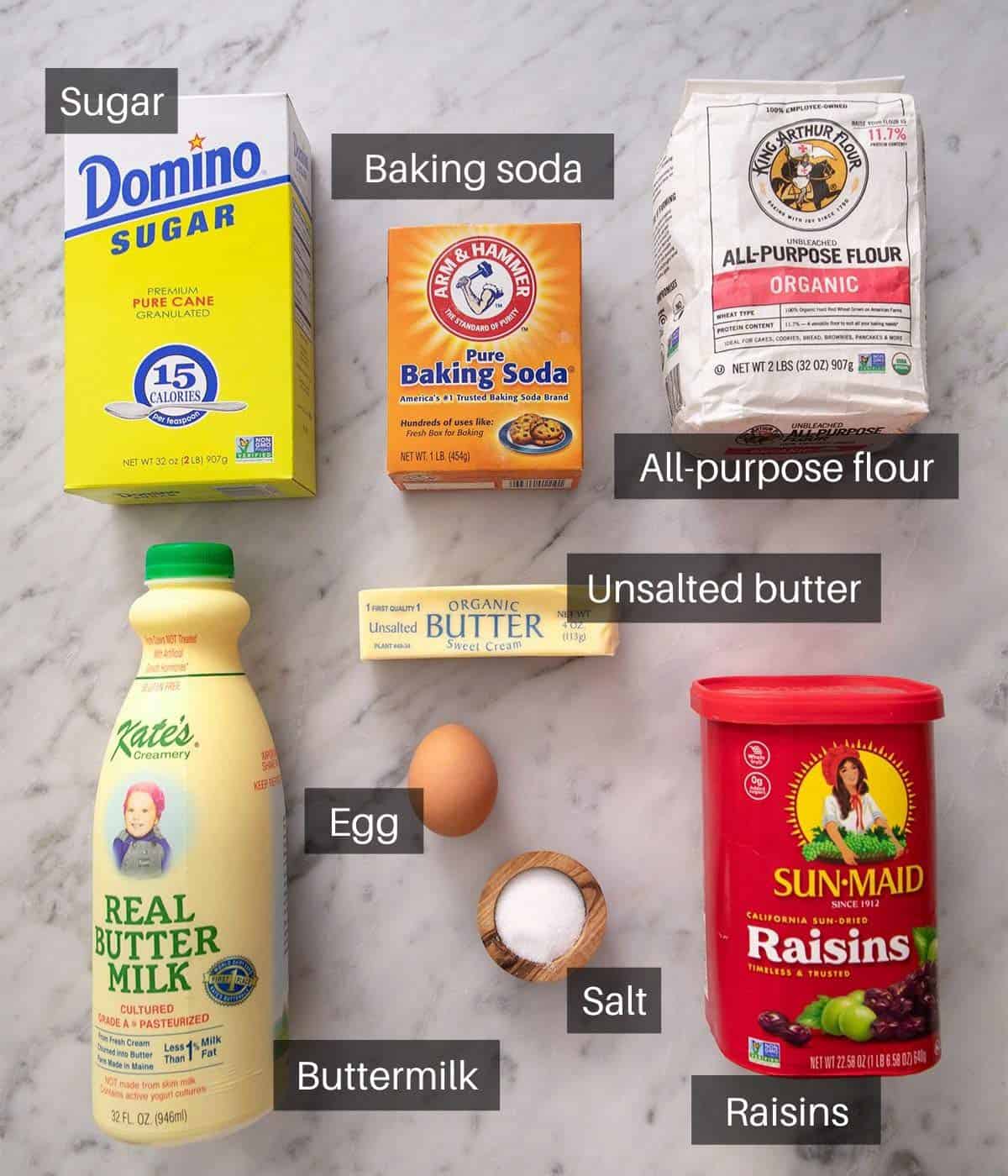
Buttermilk – cold buttermilk gives the loaf a traditional Irish soda bread taste and helps activate the baking soda. Buttermilk has a slight tang and richness which is a delightful combination for breads and dough. If you don’t have this ingredient or want to use up milk that you have on hand, learn how to make buttermilk using regular milk and lemon juice or vinegar.
Butter – cold butter is the key to success in this recipe. Cube the butter and then return it to the refrigerator until you are ready to add it to the flour mixture, especially if you are working in a warm kitchen.
Flour – the standard all-purpose flour works well for this recipe. Measure the flour carefully, weighing it with a food scale if possible, because using too much flour will result in a dry loaf of bread.
Baking soda – the key leavening agent that makes soda bread rise. While most bread loaves use yeast to create their texture, this easy loaf uses the magic of baking soda reacting with buttermilk to create pockets of gas and, in turn, a fluffy, delicious crumb!
Raisins or Currants – raisins or currants add sweetness, flavor, texture, and visual appeal. Use one or a combination of the two ingredients.
How to Make Irish Soda Bread
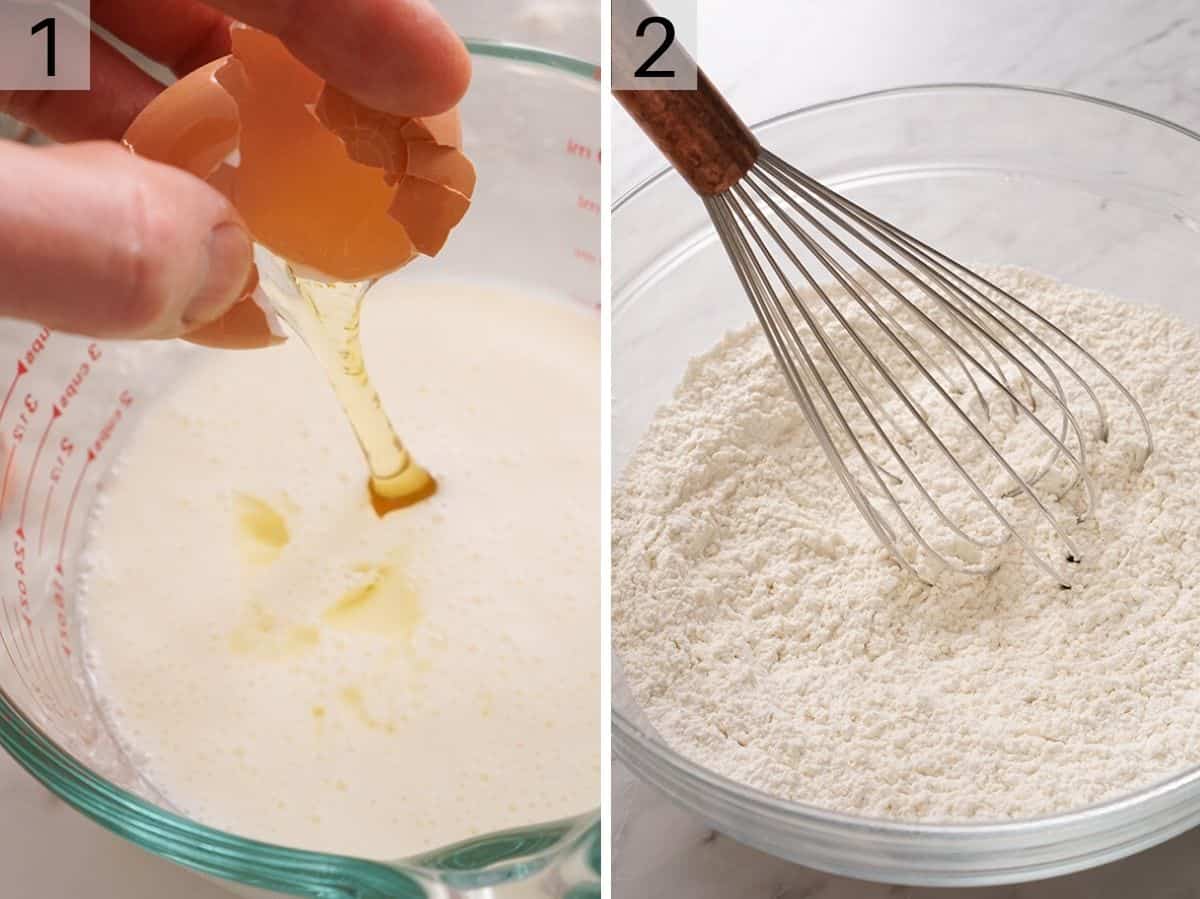
1. Whisk the buttermilk and egg together in a bowl or measuring cup, then set aside.
2. Whisk the white flour, sugar, baking soda, and salt in a large bowl. If you’re adding raisins or currants, mix those in with the dry ingredients as well.
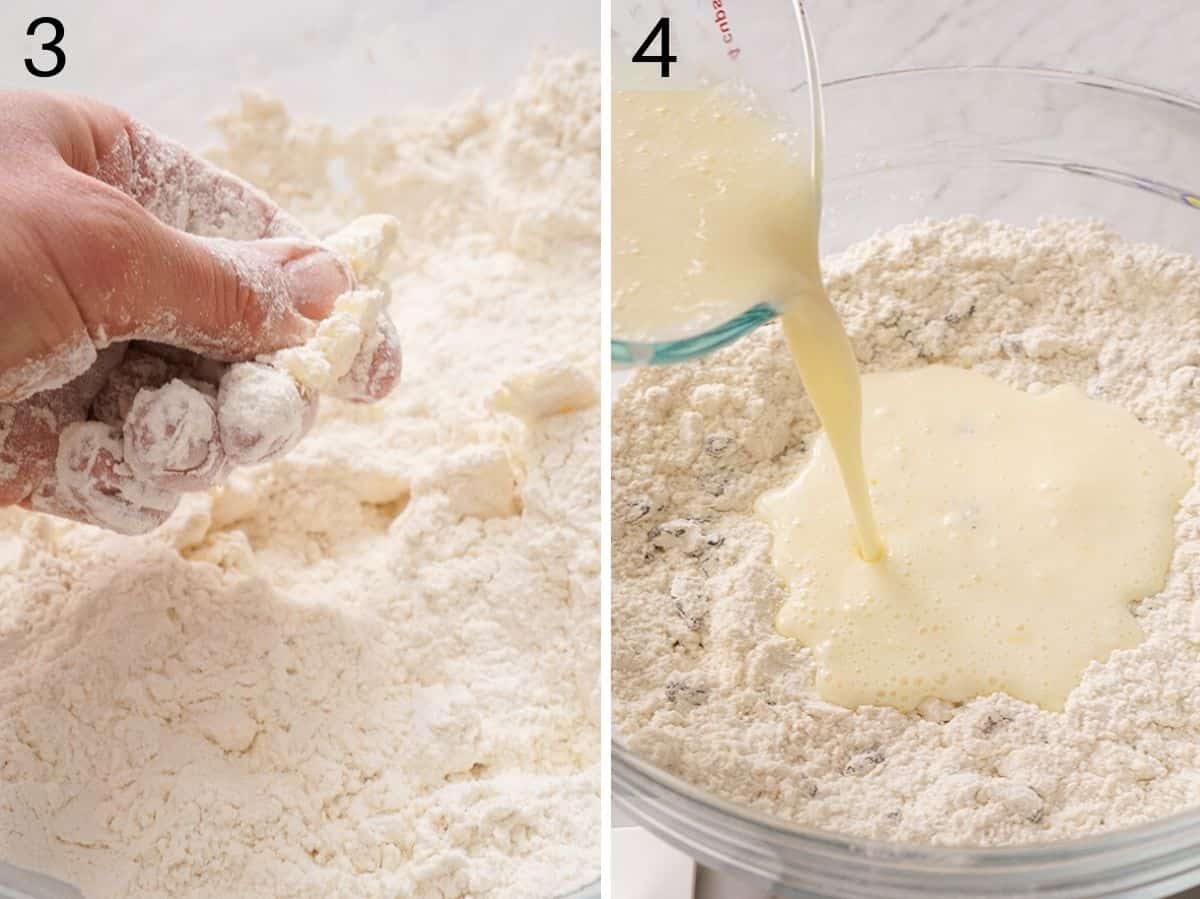
3. Add the butter to the flour mixture and work it into small pea-sized pieces with your hands or with a pastry cutter.
4. Create a well in the middle of the flour mixture and pour the buttermilk mixture in. Use a spatula or wooden spoon to fold the mixture just until a dough ball starts to form.
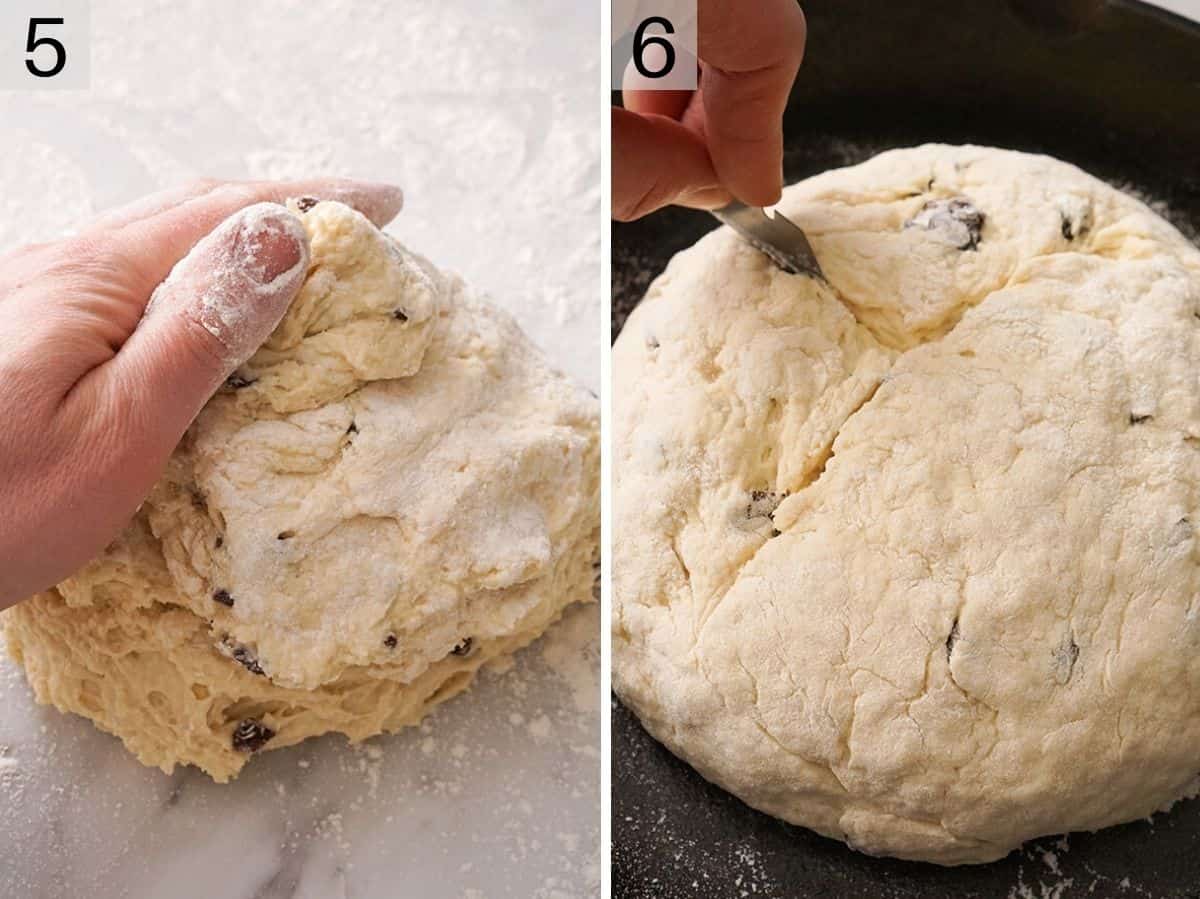
5. Transfer the dough to a lightly floured surface, form into a round loaf, and place onto a parchment-lined baking sheet or in a seasoned cast iron pan.
6. Score an “X” on the top, ½-inch deep, using a sharp knife. Bake for 25-30 minutes or until the top is golden brown and the center has set. Tent the bread with foil if the top is getting too much color. Allow the soda bread to cool on a wire rack before serving.
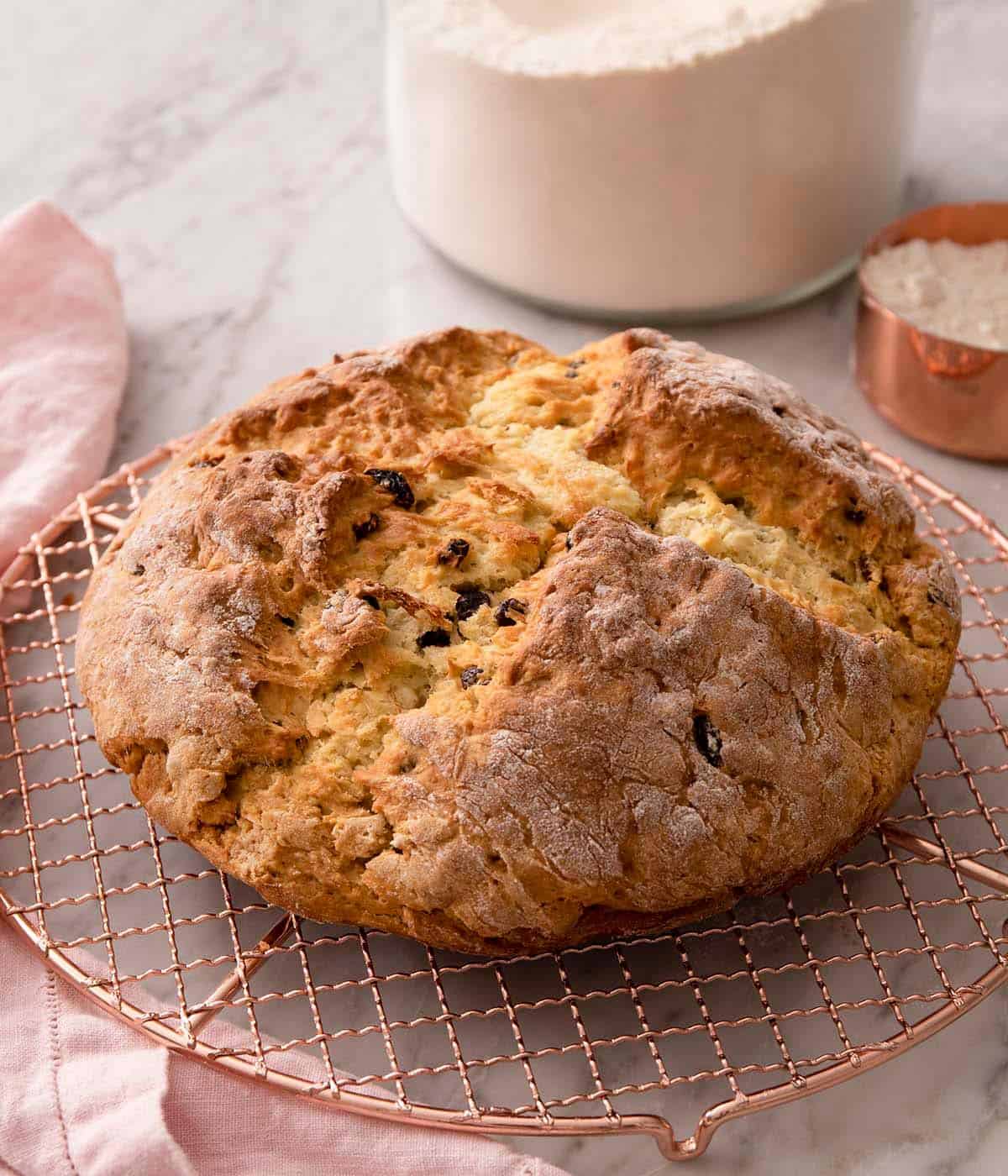
Pro Tips for Making This Recipe
- Mix by hand and avoid overworking the dough. There is no need for an electric mixer or dough hook for this recipe. Avoid overworking the dough, as doing so can result in dry, tough, and chewy bread. The dough should be a bit shaggy, and streaks of flour can remain; you just need it to come together enough to form a ball.
- Score the bread well. Scoring the bread isn’t just for looks, this step is important to help the center of the bread bake well, so make ½-inch deep score lines in the shape of an “X” all the way across the top of the loaf.
- You don’t need a special baking vessel. This easy soda bread recipe can be baked in a cast iron pan, parchment paper-lined baking sheet, cake pan, pie dish, or other round, shallow baking dish. I don’t recommend using a loaf pan because it will constrain the bread and prevent it from baking evenly.
- Bake until the exterior is golden or the center is 200°F. The bread is done when the exterior becomes golden and is hollow-sounding when tapped. For the most accurate indicator, use an instant-read thermometer to check the internal temperature of the center of the loaf and remove the loaf when it reaches 200°F.
- Tent the bread with foil if needed. If you notice that the top of the bread is taking on too much color before the center is baked, tent the top with aluminum foil.
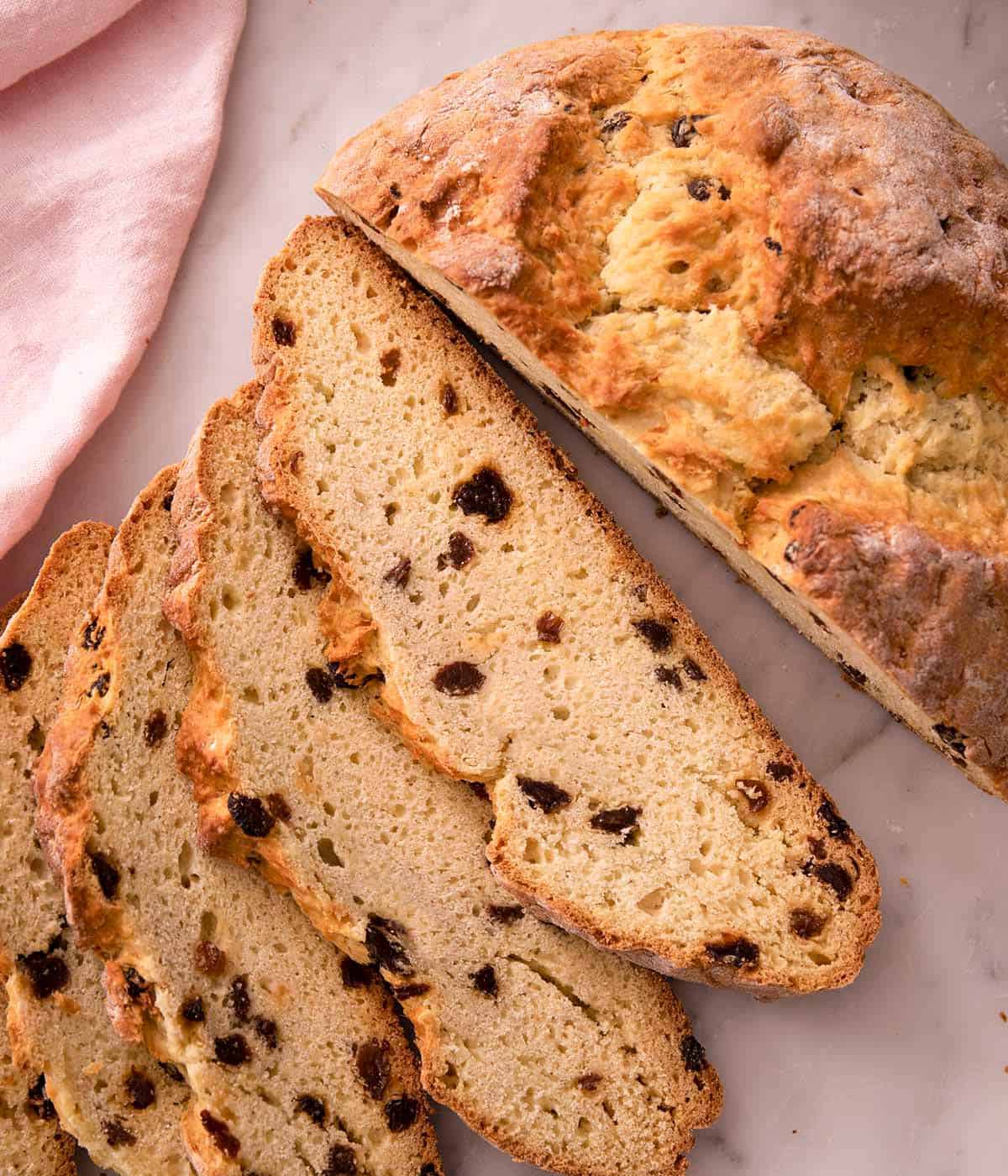
Frequently Asked Questions
Leftovers keep in an airtight container at room temperature for up to three days. Keep the loaf whole and slice only what you are going to serve to prevent the bread from drying out too quickly. Freeze leftovers for up to two months by tightly wrapping a loaf or slices in plastic wrap and then sealing the bread in a freezer bag.
Serve this no-yeast bread with Irish butter or jam and coffee or tea any time of the day, or try it with honey butter, pumpkin butter, or apple butter. The bread is a satisfying snack or the perfect side when paired with a warm and savory entree. One of my favorite ways to serve this recipe is alongside beef stew or one of my homemade soup recipes!
For additional flavor or variety, try this recipe with lemon or orange zest or go savory with a few teaspoons of minced fresh herbs. Sunflower seeds, pumpkin seeds, caraway seeds or chopped nuts are good options if you enjoy some added crunch. Alternatively, you can also stir in different dried fruit: golden raisins, dried cranberries, or diced dried apricots are all delicious in this bread.
The main difference between soda bread and many other bread recipes, is that this bread does not use yeast and instead is leavened with baking soda. Because there is no yeast and the simple ingredients combine easily, this recipe requires no kneading. The inclusion of raisins or currants is another ingredient that makes Irish soda bread unique.
Irish soda bread may become dry if it is overworked or kneaded. The bread will also become dry if it is overcooked from baking too long, if the oven is too hot, and possibly even if baked at a high altitude. All of these factors impact the moisture content of the dough. For bread that is crusty on the outside but not overly dry, mix it by hand just until it comes together before shaping to bake. If you live at a high altitude and the dough is too dry to form a craggy mass, stir in an extra tablespoon or two of buttermilk into the dough just until combined, being careful not to overwork the dough.
If you’ve tried this recipe, then don’t forget to rate the recipe and let me know how you got on in the comments below, I love hearing from you!
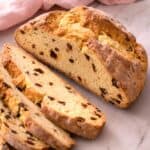
Irish Soda Bread
Equipment
- Large bowl
- Whisk
Ingredients
- 1⅔ cup buttermilk cold
- 1 egg
- 4 cups flour (480g)
- 4 tablespoons granulated sugar
- 1½ teaspoon baking soda (9g)
- 1 teaspoon kosher salt (9g)
- 4 tablespoons butter cold, diced (57g)
- 1 cup raisins optional or currants
Instructions
- Preheat oven to 425F.
- Whisk the buttermilk and egg together then set aside.
- Combine the flour, sugar, baking soda and salt in a large bowl then whisk together. If you’re adding raisins or currants then mix those in now.
- Add the butter to the flour mixture then work into small pea sized pieces with your hands or a pastry cutter.
- Create a well in the middle of the flour mixture and pour the buttermilk mixture in. Use a spatula to fold the mixture together until all the flour has been worked in.
- Transfer the dough to your lightly floured surface, form into a loaf and place onto a parchment lined baking sheet or seasoned cast iron pan.
- Score the top with an “X” and bake for 25-30 minutes or until the top is golden brown and the center is set. Tent the bread with foil if the top is getting too much color.
- Allow to cool then serve.
Notes
- Mix by hand and avoid overworking the dough. There is no need for an electric mixer or dough hook for this recipe. Avoid overworking the dough, as doing so can result in dry, tough, and chewy bread. The dough should be a bit shaggy, and streaks of flour can remain; you just need it to come together enough to form a ball.
- Score the bread well. Scoring the bread isn’t just for looks, this step is important to help the center of the bread bake well, so make ½-inch deep score lines in the shape of an “X” all the way across the top of the loaf.
- You don’t need a special baking vessel. This easy soda bread recipe can be baked in a cast iron pan, parchment paper-lined baking sheet, cake pan, pie dish, or other round, shallow baking dish. I don’t recommend using a loaf pan because it will constrain the bread and prevent it from baking evenly.
- Bake until the exterior is golden or the center is 200°F. The bread is done when the exterior becomes golden and is hollow-sounding when tapped. For the most accurate indicator, use an instant-read thermometer to check the internal temperature of the center of the loaf and remove the loaf when it reaches 200°F.
- Tent the bread with foil if needed. If you notice that the top of the bread is taking on too much color before the center is baked, tent the top with aluminum foil.



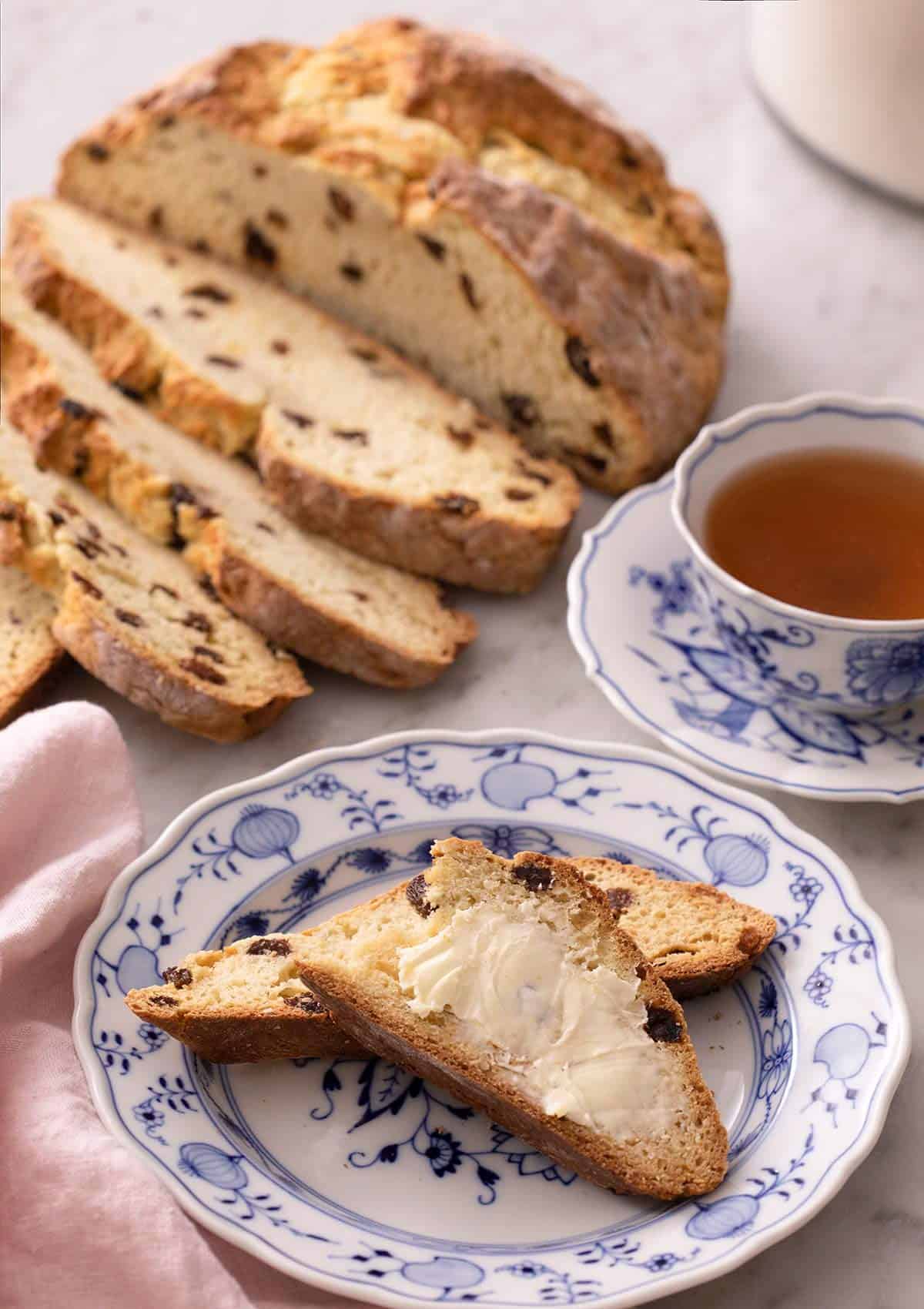
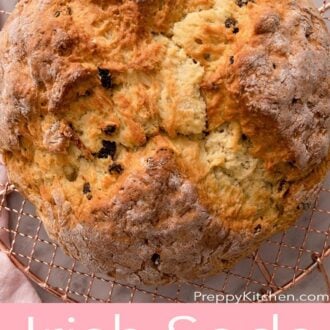
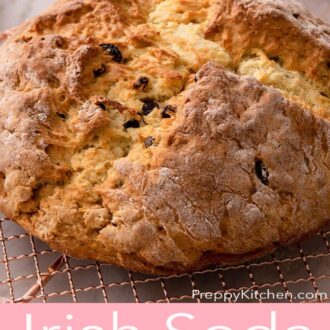
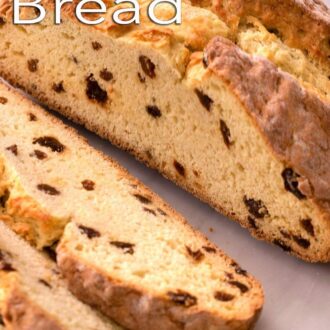
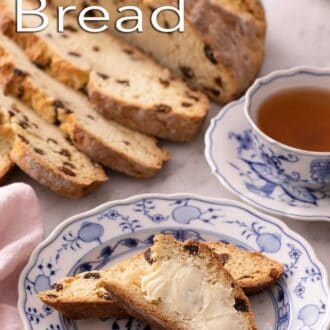
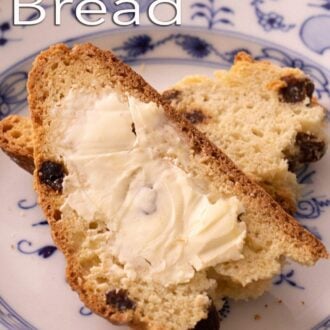
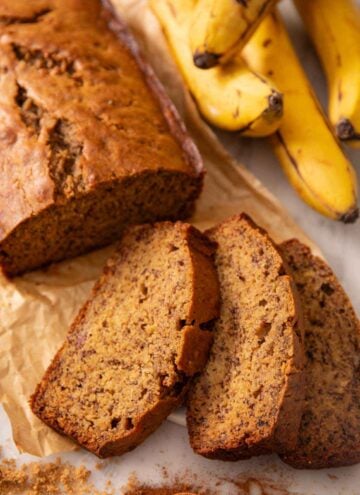
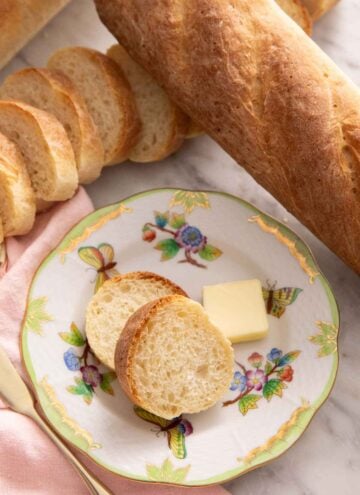
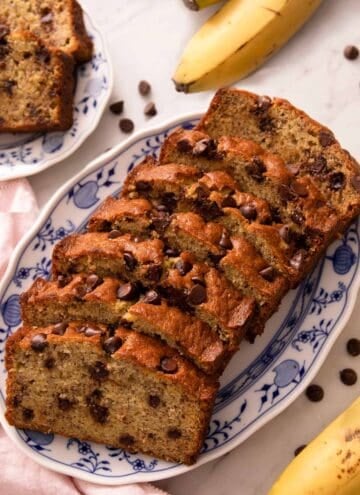
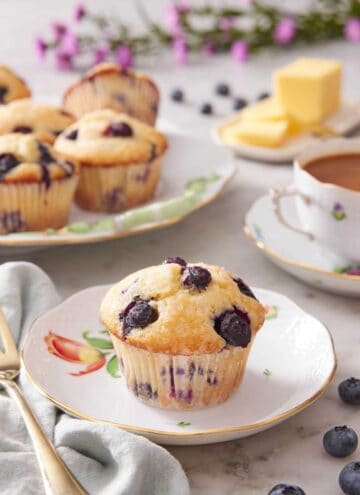
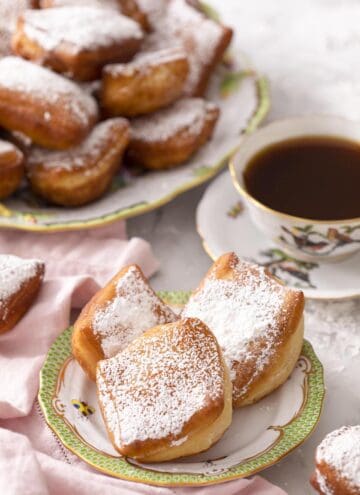
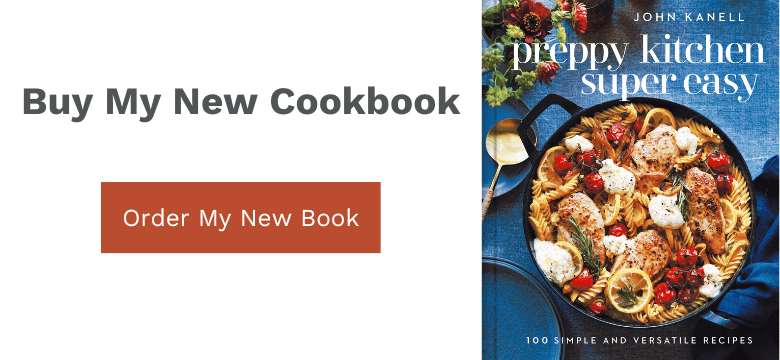
Antoinette says
Did anyone else find 25-30 a wee bit short on baking time? Good thing I decided to use a thermometer. 35-40 minutes and my oven was well preheated!
Added the zest of a Cara Cara Orange. Delicious. Hope there’s some around by time we have our corned beef dinner. Happy St Paddy’s Day!
Rowena nicolas says
sooo good and delicious
Janet says
Hi John! I made this today with Einkorn flour and in a cast iron skillet. It was so delicious! Love your YouTube videos!
Ayla says
Hello! Just wondering if you’ve ever tried a gluten free flour in your soda bread recipe.
John K. says
Hi Ayla,
I have not tried gluten free flour in this recipe.
Best,
John
Mandy says
Could Apples be added to this? If so, would that effect the cooking time? I’m new to bread making. TIA
jkanell says
I would steer clear, they are a bit too wet for the dough.
Ann says
Plain or self raising flour?
John K. says
Ann,
All purpose plain flour in this recipe! Hope you enjoy!
John
Ann says
Thank you for replying. Will let you know the tesults
Anna says
This was the best Irish Soda Bread I ever tired. We had a party and every guest was so complimentary of this bread. That will certainly my go to recipe.
jkanell says
I’m so happy you liked it! Thanks for sharing!
John K. says
Really yummy! A classic!
Avery says
This bread was fantastic! I loved the golden raisins!